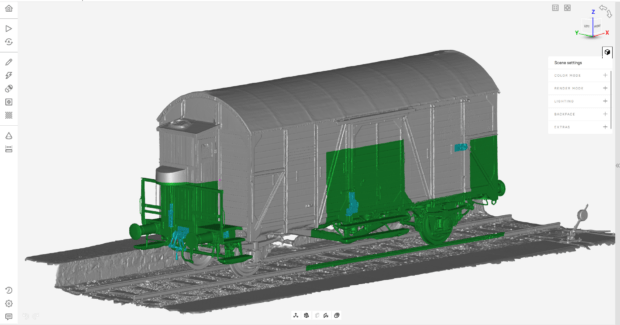New 3D Data Capture and Processing Software Features AI Photogrammetry
Artec 3D now offers Artec Studio 19, an all-in-one software solution for 3D scanning, processing, reverse engineering and quality inspection.
Posted: December 10, 2024
Artec 3D, a global leader in 3D scanning, has launched Artec Studio 19 (AS19), a professional, all-in-one software solution for 3D scanning, processing, reverse engineering, and quality inspection. Now featuring wider scanner integration, significant performance upgrades, and AI Photogrammetry, AS19 is designed to meet the demands of professionals across a wide range of industries, while offering accessibility to makers and educational users. By delivering the tools to create lifelike 3D models from scans, photos, and videos, AS19 expands what’s possible with 3D technology.
“Artec Studio 19 represents the next step in the evolution of our industry-leading software,” said Art Yukhin, President & CEO of Artec 3D. “With AI Photogrammetry and extensive new 3D modeling, reverse engineering, and quality inspections tools, AS19 empowers professionals and opens the door for anyone to explore the limitless possibilities of 3D technology.”
What makes Artec Studio unique?
Artec Studio 19 stands out as a versatile software, combining essential features for 3D scanning, processing, editing, reverse engineering, and quality inspection into a single platform. AS19 also allows users to complete up to 80% of tasks directly within one software, reducing the need for other high-end tools and making it a cost-effective solution for multiple industries and use cases.
The software works seamlessly with all types of Artec 3D scanners, including LiDAR, laser, and structured light. AS19 now extends its compatibility to the new metrology-grade Artec Point laser scanner, which ensures precise measurements for the most demanding tasks. Additionally, now it introduces photogrammetry for integrating data from any camera-equipped device, including smartphones.
Using Artec Studio’s breakthrough Smart Fusion algorithm, users can even merge data captured by different types of 3D scanner together. Drawing on the highest resolution data from each scan, the industry-first feature delivers ultra-detailed 3D models at high-speed.
Artec Studio 19: Faster, smarter, and more user-friendly
The latest version of Artec Studio introduces significant upgrades for faster processing, improved editing or analysis, and the integration of new image data types.
Turbocharged algorithms expedite processing, fusing mesh data 2.5x faster and simplifying at 10x the pace, to accelerate users’ workflows. Altogether, the AS19 global registration, fusion, optimization, and texturing process is now 2x faster than its predecessor.
AS19 significantly improves 3D scan editing and analysis. Enhanced Auto-surfacing allows scan data to be converted to solid CAD surfaces with fewer patches, improving the quality of results. Likewise, users can deploy Faster Boolean Tools for uniting, subtracting, and intersecting meshes, or Fill Gaps With Offset Copies for essential edits at pace.
Inspection users will also be glad to hear that Artec Micro II now supports full automation, so they can capture in one click, then send data through a preset analytical pipeline.
Expanded compatibility and new features include:
- AI Photogrammetry: Create 3D models directly from photos and videos using the power of artificial intelligence.
- Metrology scanner support: Artec Studio 19 adds compatibility with the Artec Point laser scanner, ensuring precise measurements for metrology-grade tasks.
- Ray II ‘Street View’ mode: Explore large point clouds in 3D, compare scan data with photos, and ensure comprehensive scene capture.
- USDZ File Type Support: Share detailed assets such as AR and CGI models using the compact and widely supported USDZ format.
- HDR & 16-bit Texturing: Capture high-contrast HDR textures and realistic 16-bit data with scanners like Artec Ray II, Leo, Eva, and Spider II.
- More Intuitive UI: Larger project thumbnails that update in real time and a cleaner layout make the software easier to navigate and use.
These features reduce manual work, and empower users to complete their projects faster, and with greater accuracy and ease.
AI Photogrammetry: Accessible high-quality 3D modeling
Artec Studio 19’s headline new feature, AI Photogrammetry, enables users to create lifelike 3D models from photos and videos captured with any camera-equipped device. Powered by an in-house developed neural engine, the technology recreates traditionally challenging shiny, transparent, complex, and featureless surfaces with high accuracy.
“AI Photogrammetry’s integration into Artec Studio 19 changes everything,” added Yukhin. “Now, anyone with a camera, even those with a smartphone, can create professional, lifelike 3D models with ease.”
Behind AI Photogrammetry are two advanced algorithms that reconstruct objects and scenes from 2D images. Users only need to follow a straightforward three-step workflow: capture, align, and create. Designed to be ultra-intuitive, this process improves the accessibility of 3D model making, for both professionals and beginners.
Using the technology, makers can quickly create 3D printing models, and museums are able to archive anywhere, while e-commerce businesses unlock the ability to digitize products without specialized hardware. AS19 also provides educators with access to incredibly user-friendly tools, making it easier to teach students about 3D technologies.
With AI Photogrammetry, AS19 is capable of capturing areas beyond the reach of existing 3D scanners, digitizing aerially from above, below the sea, or at a micro-level. This creates fresh opportunities for 3D scanning professionals.
Augmenting Artec Ray II LiDAR data with drone footage, for instance, offers the perfect construction solution. Users can also digitize forensic scenes with photogrammetry, before picking up clues using high-resolution handheld 3D scanning.
“Artec Studio 19 bridges the gap between professional-grade performance and recreational accessibility,” explained Yukhin. “For professionals working in fields like reverse engineering, manufacturing, and CGI, it’s not just an invaluable workflow tool, it offers a reliable interim solution when 3D scanners are unavailable. At the same time, hobbyists can also use smartphones to create high-quality 3D models on the go.”















